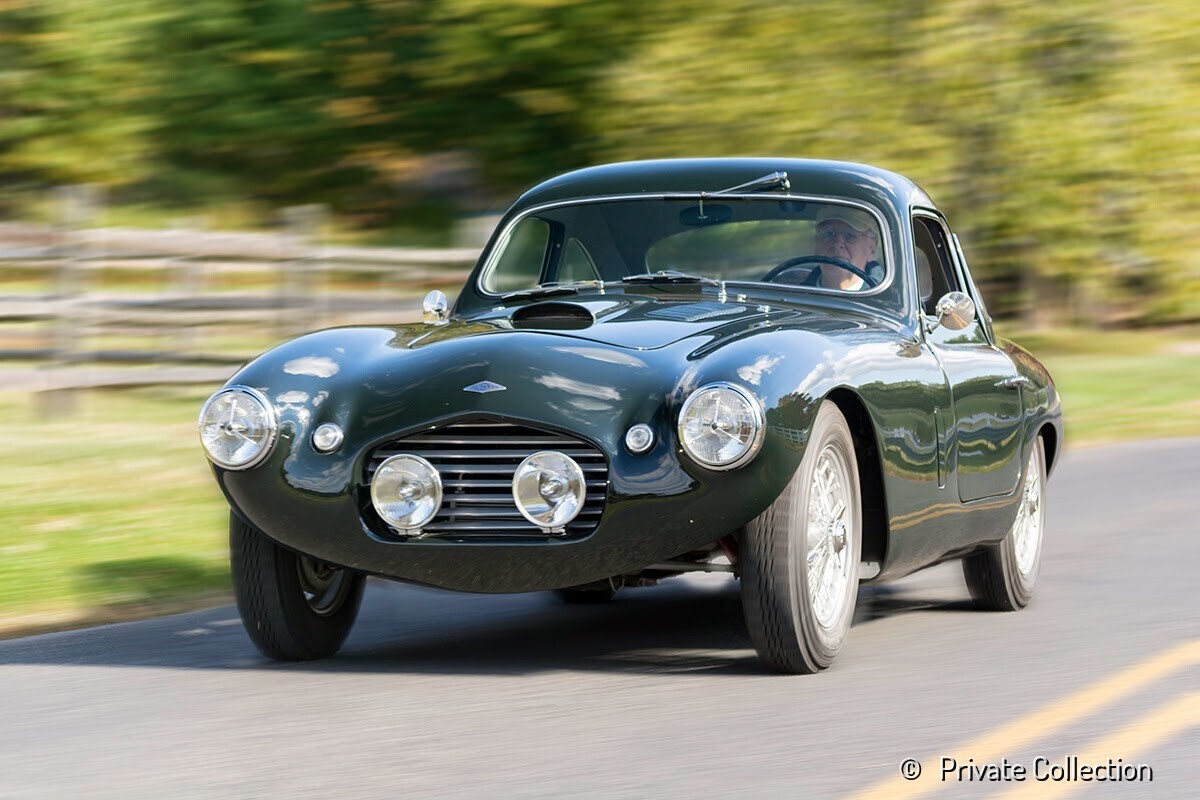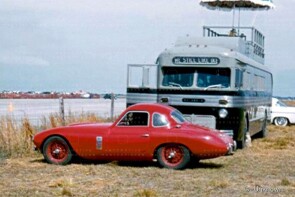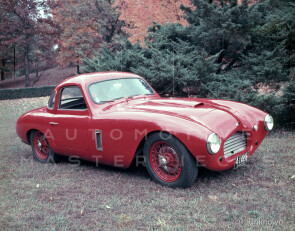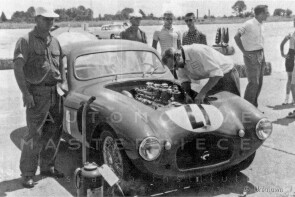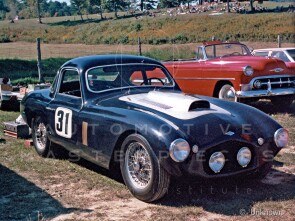
1954 Frazer Nash Le Mans Fixed Head Coupe
ON/OFF
Why am I an Automotive Masterpiece?
G. Team cars
Frank Harrison's private racing team
L. Limited edition cars
no. 9 manufactured, no. 9 remaining, 3rd built
Frazer Nash was founded in England in the early 1920s, a direct heir to the experience gained by Archibald Frazer-Nash and Ron Godfrey with the GN Cyclecars. From the very beginning, the company stood out for its original technical solutions, such as the chain drive to the rear wheels, which eliminated the differential and reduced weight, offering a direct and sporty driving feel. Between 1924 and 1939, around 350 cars were built, all agile, essential and intended for enthusiastic drivers. After the 1927 crisis, AFN Limited continued the activity under the direction of the Aldington family, becoming in 1934 the British importer and assembler of BMWs, which were marketed as “Frazer Nash BMW.” The company held the official import franchise until the outbreak of war in 1939. After the conflict, the close relationship established with BMW proved advantageous: what remained of the heavily damaged German factory, including valuable components and technical material that had not been confiscated, found its way to AFN’s Falcon Works in Isleworth. At that time, the Bristol Aeroplane Company — seeking to enter the postwar automobile industry — acquired a controlling interest in AFN, with the intention of producing cars powered by a Bristol-built version of the prewar BMW engine. The plan was to sell touring models under the Bristol name, while reserving the Frazer Nash badge for the sports cars. However, the collaboration between the two companies soon encountered difficulties, and each followed its own path. Despite the separation, Bristol agreed to continue supplying AFN with engines and transmissions, ensuring the continuation of the Frazer Nash sporting lineage. The first postwar Frazer Nash retained many features of the prewar BMW 328, not only in its technical layout but also through the involvement of its original designer, Fritz Fiedler, who developed a new tubular frame chassis combining suspension elements from the BMW 328 and 326. This design became the foundation for the renewed production at Isleworth and for the brand’s immediate return to the racing scene. Frazer Nash was soon once again at the heart of postwar competition, fielding cars that reflected both German engineering heritage and British craftsmanship. Frazer Nash found in this rebirth a second youth, devoting itself to the construction of small, high-quality sports cars. The chosen engine for this new phase was the Bristol inline six-cylinder, directly derived from the BMW 328 unit, which became the core of the models produced between 1948 and 1957. The first of this series, the Le Mans Replica, was presented in 1948 and quickly consolidated the brand’s reputation thanks to its successes in international competitions, including a prestigious third place overall at the 1949 24 Hours of Le Mans. It was followed by the Mille Miglia, Targa Florio and Le Mans Coupé versions, the latter featuring a closed body, all built in very limited numbers and intended for private drivers. Each car was built by hand, with a light tubular chassis and essential but finely crafted bodywork, reflecting the precision typical of small-scale English production. The technical layout remained traditional, with front engine and rear-wheel drive, but the compactness and lightness provided great balance and superior handling for its time. Between 1948 and 1957, a total of 86 examples (plus 2 bare chassis) are reported to have been produced. The rapid technical evolution and the growing industrialization of the automotive sector made it difficult for such a small manufacturer to compete with larger firms. Production ended in 1957, but the name Frazer Nash remained tied to an idea of pure sportiness — an ideal bridge between the pioneering era of British cyclecars and the technical maturity of postwar GT competition cars.
The Frazer Nash Le Mans Coupé was introduced between April 1953 and October 1956 as the first closed-body model produced by the small British manufacturer. Its creation was the natural evolution of the postwar sports series, whose origins traced directly back to the pre-war BMW 328 and to the work of its own designer, Fritz Fiedler. After the conflict, Fiedler developed for Frazer Nash a light tubular chassis with suspension derived from the BMW 328 and 326, a technical foundation that enabled the Isleworth company to return immediately to international competition. On this architecture was based the Le Mans Replica, the cycle-fendered car that brought “Aldy” Aldington and Norman Culpan to a third-place overall finish at the 24 Hours of Le Mans, followed by the full-bodied version known as the Mille Miglia, named after its success in the famous Italian thousand-mile race. The two configurations continued to perform consistently in competition, but in 1953 new sporting regulations banned cycle-fendered cars and introduced restrictions on windscreen height. Frazer Nash responded to these changes with a completely revised model: the Le Mans Coupé. The first prototype was conceived as an evolution of the Mille Miglia, featuring a closed body, fixed roof and a larger front grille to improve cooling in endurance events. This closed version was conceived as a fast grand tourer, yet it is remarkable that one third of the entire production raced at Le Mans. Even though it was not regarded as competitive as the other Frazer Nash models, it nevertheless achieved excellent results. Compact and purposeful in appearance, with low and clean lines, it retained the functional purity that was a hallmark of the marque. The chassis remained a light steel space frame with aluminum bodywork, front-engine and rear-wheel drive layout. The 1,971 cc Bristol inline-six, a direct descendant of the BMW 328 unit, produced around 140 hp at 5,500 rpm, ensuring lively performance for a car weighing roughly 760 kg. The suspension combined BMW components with original Frazer Nash solutions, and the balanced weight distribution gave the car exceptional precision and responsiveness. The Le Mans Coupé made its debut at the 1953 Silverstone International Meeting, finishing seventeenth, before competing in the 24 Hours of Le Mans later that year, where it achieved thirteenth overall and won the two-litre class. The following year another example finished eleventh overall. Production continued until 1956, with only nine cars built — a figure that highlights the artisanal and exclusive nature of the Isleworth workshops. The Le Mans Coupé represented the most mature expression of the Frazer Nash tradition: a refined, light and fast machine, built with meticulous craftsmanship and designed for endurance racing. It was the answer of a small constructor to the technical challenges of a rapidly changing era, blending the German engineering heritage of the BMW 328 with the precision and character of British craftsmanship. All nine examples are known to survive as of 2025, a testament to the historical and technical significance of a model that remains one of the most important expressions of postwar British sports-car design.
The Frazer Nash Le Mans Fixed Head Coupé (this was the full name as reported in period advertisements) with chassis no. 421/200/196 was completed in 1954 and belongs to the 200 series. In AFN’s production records, chassis numbering distinguishes the different postwar phases: the 421/100 series identifies the early Le Mans Replica cars with cycle fenders, the 421/200 series includes the later full-width body models – among them the Mille Miglia, Targa Florio and Le Mans Coupé – of which 47 complete cars and 2 bare chassis were built, while the 421/300 series marks the final road-going cars produced between 1956 and 1957. Chassis no. 421/200/196 is one of only nine examples built of the model. It is also the only car in the series constructed with left-hand drive, ordered by Jo Conn Guild Jr., a well-known businessman and prominent civic figure in Chattanooga, Tennessee. He was best known as TEPCO’s president and became a key figure in the nationally significant legal battle opposing the federal takeover of private electric utilities: a landmark case in American industrial and legal history. Guild visited the Falcon Works in late 1953 or early 1954, ordering the car with a number of special features that made it unique. Guild, who at the time was around seventy, was regarded as one of the most enthusiastic sports-car devotees in his area. A lifelong motoring enthusiast, he owned high-level sports cars including Jaguars and Ferraris, but had a particular devotion to his Frazer Nash. Interviewed by the Chattanooga Daily Times in September 1958, he explained that this type of car was “...custom made for the buyer. I was measured for that car like I would be for a suit of clothes.” An experienced driver, he loved attending races, although he considered himself too old by then to compete personally. For Guild, who was over six feet tall and of imposing build, the bodywork of the Coupe was modified at the factory at his request, with the roof raised by one inch and the addition of a third windscreen wiper mounted at the top of the screen. The car was also equipped (as required by the LHD configuration) with an Austin Cambridge pedal assembly, front and rear bumpers, fog and driving lamps, adjustable radiator louvres and other special fittings specified by the customer. Technically, the car was fitted with the Bristol BS4 inline six-cylinder engine of 1,971 cc, coupled to a four-speed manual transmission and rear-wheel drive. The chassis was a tubular steel spaceframe with an aluminum body, originally finished in Ash Grey with black Vaumol VM 8500 leather upholstery. Other notable features included knock-on wire wheels on 42 mm hubs, Al-Fin brake drums, adjustable Andre shock absorbers, adjustable torsion bars, an Austin 3.66 differential taken from the J.O. Patino’s chassis no. 178 returned to the factory badly crashed and used for spares, an adjustable steering wheel, remote gear lever and a 22-gallon fuel tank. The exact completion and delivery dates are not recorded, but it is presumed that construction and delivery took place around May 1954, after the return of the Patino chassis from which the rear axle was sourced. AFN neglected to photograph the completed car and recorded only a few production notes. Dennis “Jenks” Jenkinson, the well-known journalist and, above all, leading AFN archivist, claimed to have obtained little or no information from the time of the car’s delivery until the early 1990s, regarding what was referred to as “The Left-Hand Drive Mystery Coupé.” We know that chassis no. 421/200/196 was delivered directly to Guild in Chattanooga, who mainly used it as an occasional road car and was later repainted red at an unknown date. Photographs dated 1958 confirm its appearance at that time, as well as its presence at Sebring in March 1956 during the 12 Hours of Sebring, where Guild attended the “Florida International Grand Prix of Endurance” as a spectator. While a period sporting activity under Guild’s ownership cannot be ruled out, it still requires verification. Two vintage plaques were affixed to the car’s dashboard over the years — “20th May 1956, Cumberland National Championship Sports Car Races – Fifth Race, Tri-State Trophy” and “10th June 1956, Lawrenceville Sports Car Race” — yet no contemporary evidence has so far been found to confirm its participation, and research on these events remains ongoing. In March 1960 it was sold to his younger friend J. Frank Harrison, another prominent Chattanooga businessman and racing enthusiast, owner of several important competition cars. Harrison entrusted its maintenance to specialists Bill Warren and Bert Kemp, and it is believed that Harrison, as racing team’s owner, entered the car several times in Southeastern regional SCCA events for top driver Sierra “Smokey” Drolet. One documented event was the SCCA race at Courtland Air Base (Alabama) in July 1960, where the Frazer Nash, however, failed to start due to a steering coupling failure.After the season, Harrison gave the car to his employee Mack Williams, and in February 1962 it was sold to Fred Moore, also of Chattanooga. Moore tried to sell it, probably through an advertisement in Road & Track in 1966, but without success. Later, a collapsed garage roof severely damaged the bodywork, particularly the bonnet and roof. Years later, in 1972, collector and vintage racer Gary Ford of Pennsylvania, looking to buy a Frazer Nash, remembered having seen the advertisement in Road & Track and, finding it again, called the number. Unexpectedly, he discovered that the car was still for sale, though in much worse condition due to the collapse of the garage. Apart from the damage, however, the car was largely complete and original, except for the fuel tank, which had been replaced with a much larger 36-gallon unit. Ford repaired the roof, replaced the bonnet and repainted it dark blue, using it in several historic racing events. During a competition at Lime Rock Park in 1996, a failure of the fibre steering coupling (again!) caused an accident that seriously damaged the car. In 1998 Ford sold it to Sandy Sadtler, also of Pennsylvania, who carried out a complete restoration while preserving the car’s originality and limiting new welds to a single small panel. Once completed, the car took part in the Colorado Grand 1000 in 1999. In January 2006 Sadtler sold the car to Frank Allocca of New Jersey, who had it repainted dark green. In 2014 it was acquired by Parisian collector Jean Laurent-Bellue, who entered and drove it at the Le Mans Classic in 2016 and at the Goodwood Revival in 2017. After being sold in 2018 to collector Albert Streminski, the car appeared in major international events, including the Tour Auto, the Concorso d’Eleganza Villa d’Este and the 2024 Mille Miglia. It has been issued a FIVA passport. It is today part of the Il Maneggio collection, with which it has taken part in further events. Chassis no. 421/200/196 today retains all its original technical features and its distinctive handmade character, such as the two front fenders, which are visibly different in length.
